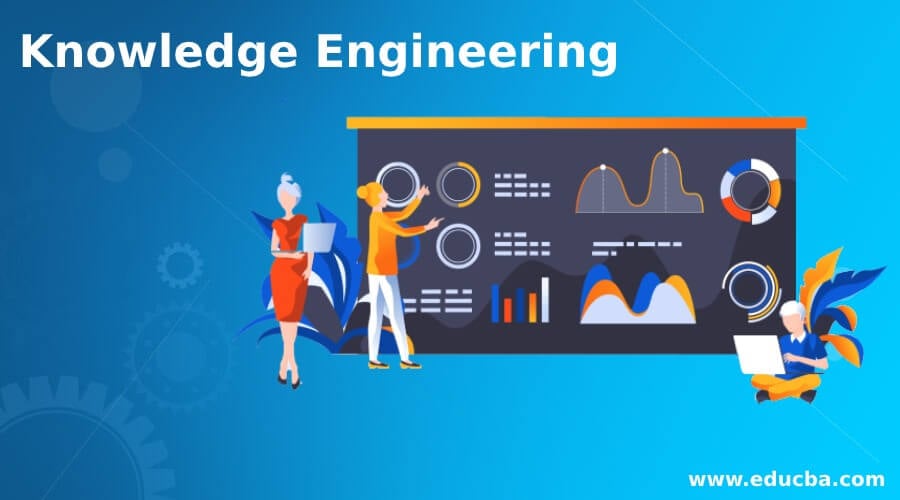Updated June 9, 2023

Introduction to Knowledge Engineering
Knowledge Engineering, as the name suggests, is an Engineering of knowledge. It is different than classical engineering, such as mechanical. Civil, manufacturing, or any other engineering. Engineering refers to the action of working artfully to bring something about. In artificial intelligence, our goal is to imitate the intelligence of a human being. Human uses their intelligence based on their knowledge to make decisions. The human decision-making system is quite complex; it takes into consideration facts from several sources, prior experiences, and emotions (like compassion -soft decision; gut-feeling -tough decision; happiness -promises; anger -quarrel; sadness wrong or unhealthy decisions), which brings nonlinear patterns in making decisions.
Knowledge engineering is a field where we engineer all such thought processes for specific domains. AI can be considered the building block that aims to mimic the decision-making abilities of human experts in particular domains.
What is Knowledge Engineering?
Simply put, it is a field that concentrates on creating a knowledge base for a specific domain. It includes an in-depth investigation of a particular domain, learning all its essential concepts, and drafting out meaningful output.
Knowledge Engineering is a way to process the information of how an expert in a specific domain would process and accordingly will act and make decisions. For example, we want to automate the teaching process for children in mathematics. It will require the knowledge of teachers, subject matter experts, and data from previous batches and their performance in maths.
In the general workflow, we need to process the metadata (all about data, its quality, content, structure, objects, and format) to have a basic idea of what it takes to decide. Generally, it takes a problem to solve and then studies the factors that a human expert will consider while making a decision. A human expert will consider several parameters; some will be more important than others. After considering all the parameters, the human expert makes permutations and combinations using his prior experience with the domain, gives weightage to all the parameters, and makes a decision. This all happens in some fractions, but investigating the whole process takes a reasonable amount of time, depending on the complexity of the problem.
The base that helped create expert systems, where knowledge is transformed into computer programs, is knowledge engineering. Expert systems have a huge and flexible knowledge base integrated with mechanisms that specify how to use the information of the knowledge base and apply it to various situations. These expert systems also use machine learning and deep learning algorithms to learn as humans do. People use expert systems in various industries, such as education, healthcare, financial services, manufacturing, etc.
Process of Knowledge Engineering
Knowledge Engineering for domains is different but follows the same rules/procedures to create expert systems.
1. Task Identification
The task is defined in this initial stage. We would take a specific problem or a combination of several problems in a domain. This task must be realistic, and the subject matter expert shall have a clear picture of what it is so that other processes can occur.
2. Acquisition of Knowledge
Once we have well-defined the problem, the next step involves gathering relevant knowledge and information about it. For some problems, standard data must be collected; for example, a problem on a heat exchanger requires the standard steam table data at x temperature and y pressure, which will be the enthalpy value.
3. Prepare a Road Map
Once the goal and knowledge base are available, the next step is to prepare the roadmap by breaking the goal down into small steps using questionnaires and a relevant knowledge base. Here subject matter expert puts his thoughts on how he would make decisions and what parameters would be considered at all stages. There could be several ways to solve some problems, and all should be considered.
4. Encode
Now it’s time to convert this knowledge into computer language. Here, different functions are used to encode the knowledge, and in some cases, an algorithm is employed to create a model for a particular task. These models can make decisions based on available parameters as an expert does; indeed, the model must be trained and tested on sufficient data.
5. Evaluation and Debugging
When creating an expert system, evaluating and debugging the model at each step is essential before integrating it into the workflow. Assessing the individual small tasks and ensuring their successful evaluation is crucial before assembling them to create a complete expert system. We again evaluate the system on similar problems and debug it if any issues exist.
6. Justification & Explanation
Here the model is justified for the given task, and working is explained.
Benefits of using Knowledge Engineering
We live in an era where we use several apps and websites through smartphones, and when faced with any issue, we seek solutions through a support center with experts; based on their availability, the issue is addressed. The expert systems created with knowledge engineering can instantly address the issue like human experts.
The benefits of Knowledge Engineering are as follows:
- Knowledge engineering helps in creating a better expert system.
- We can assemble different domain knowledge to address complex problems.
- Models created with knowledge engineering are robust.
- When coupled with NLP, these can read the queries and provide solutions, like a chatbot.
Conclusion
In Knowledge engineering, we try to emulate the thought process of an expert in a particular domain. The general rule is to set tasks, and take up questions and issues like an expert would do before deciding. Create a road map to conclude. The model needs corresponding knowledge, expertise, and a troubleshooting approach if something goes wrong to reach the goal. The models created with knowledge engineering are robust and highly accurate.
Recommended Articles
This is a guide to Knowledge Engineering. Here we discuss the introduction, process, and benefits of using Knowledge Engineering. You can also go through our other related articles to learn more –

